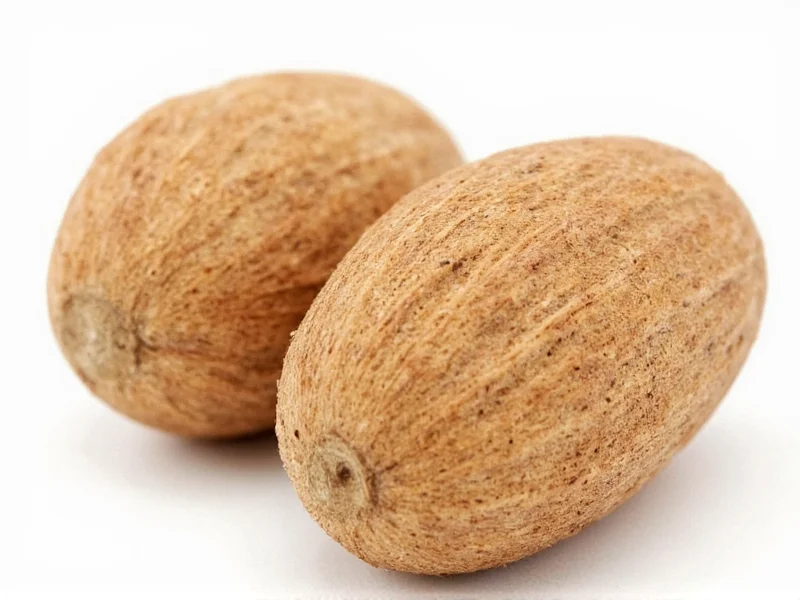Understanding the relationship between nutmeg and mace is essential for successful spice substitution in your cooking and baking. Though they come from the same plant, these spices have distinct flavor profiles that affect how they perform when swapped in recipes. This guide provides practical, kitchen-tested advice for substituting nutmeg for mace across various culinary applications.
The Botanical Connection Between Nutmeg and Mace
Nutmeg and mace both originate from the Myristica fragrans tree, making them botanical siblings rather than completely different spices. Nutmeg is the seed itself, while mace is the lacy red aril (covering) that surrounds the seed. This shared origin explains their similar flavor compounds, yet their different compositions create unique culinary characteristics.
Mace contains higher concentrations of myristicin and elemicin, giving it a more delicate, citrusy flavor with subtle pepper notes. Nutmeg, being the seed, has a stronger, warmer profile with pronounced earthy and slightly sweet characteristics. When considering how to substitute nutmeg for mace in baking, these flavor differences become particularly important.
Practical Substitution Guidelines
The standard substitution ratio works well for most applications, but certain recipes require more nuanced adjustments. Understanding the nutmeg vs mace flavor difference helps determine when to modify the basic ratio.
| Recipe Type | Standard Ratio | Recommended Adjustment | Best Application Notes |
|---|---|---|---|
| Baked goods | 1:1 | Use 3/4 tsp nutmeg per 1 tsp mace | Ideal for pumpkin pie, spice cakes, and cookies |
| Savory sauces | 1:1 | Use 2/3 tsp nutmeg per 1 tsp mace | Works well in béchamel and cheese sauces |
| Meat dishes | 1:1 | Use equal amounts | Excellent for sausages and meatloaf |
| Delicate custards | 1:1 | Use 1/2 tsp nutmeg per 1 tsp mace | Prevents overpowering the subtle flavors |
When Substitution Works Best
Not all recipes respond equally well to nutmeg replacement for mace in savory dishes. Consider these factors when deciding whether to make the substitution:
- Recipe intensity - Stronger-flavored dishes (like hearty stews) can handle the more robust nutmeg flavor better than delicate preparations
- Cooking time - Longer cooking times mellow nutmeg's intensity, making it more comparable to mace
- Other spices present - Recipes with multiple warm spices (cinnamon, cloves, allspice) balance nutmeg's stronger profile
- Final dish color - Mace produces a lighter color, important in pale sauces and light-colored baked goods
For specific applications like pumpkin pie, many home cooks wonder can I use nutmeg instead of mace in pumpkin pie. The answer is yes, but with caution. Traditional pumpkin pie recipes often call for mace because its lighter flavor doesn't overwhelm the delicate pumpkin taste. When substituting, reduce the amount by 25% and consider adding a tiny pinch of citrus zest to mimic mace's brighter notes.
Advanced Substitution Techniques
Professional chefs often employ these techniques when working with nutmeg vs mace in recipe development:
- Layering spices - Add half the nutmeg early in cooking and the remainder near the end to preserve volatile flavor compounds
- Temperature control - Nutmeg's flavor intensifies with heat, so reduce cooking temperature by 25°F when substituting
- Acid balancing - Add a small amount of citrus juice or vinegar to recipes when substituting nutmeg for mace to mimic mace's brighter profile
- Texture consideration - Freshly grated nutmeg has more intense flavor than pre-ground; adjust quantities accordingly
Storage and Freshness Considerations
The shelf life of these spices affects substitution success. Whole nutmeg retains freshness significantly longer than mace blades. When substituting older spices, you may need to increase the quantity by 20-30% to achieve equivalent flavor impact. For the best nutmeg substitute for mace in recipes, always use freshly grated spices rather than pre-ground versions when possible.
Ground mace loses potency within 6 months, while ground nutmeg maintains quality for 8-10 months. This difference becomes crucial in recipes where precise spice measurement matters, such as in professional baking or delicate sauces.
Alternative Substitutes When Neither Spice Is Available
If you need a nutmeg and mace alternative for holiday baking, consider these options:
- Allspice - Use 3/4 teaspoon allspice for every 1 teaspoon of mace (best in sweet applications)
- Garam masala - Substitute 1/2 teaspoon for 1 teaspoon mace in savory dishes
- Cinnamon with a pinch of cloves - Works well in baked goods but lacks the citrus notes of mace
- Pumpkin pie spice - Use 7/8 teaspoon for every 1 teaspoon mace (ideal for autumnal recipes)
Remember that these alternatives change the flavor profile more significantly than the nutmeg-mace substitution. They work best when the original recipe calls for multiple spices rather than relying solely on mace or nutmeg.
Final Substitution Recommendations
When deciding when to use nutmeg instead of mace, consider your recipe's primary flavor goals. Choose nutmeg when you want a stronger, warmer spice presence. Opt for mace when you need a more delicate, nuanced flavor that won't dominate other ingredients. In most cases, the substitution works well with minor adjustments, making these spices valuable alternatives in any well-stocked kitchen.











 浙公网安备
33010002000092号
浙公网安备
33010002000092号 浙B2-20120091-4
浙B2-20120091-4